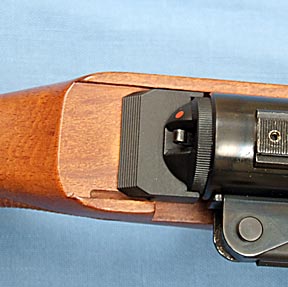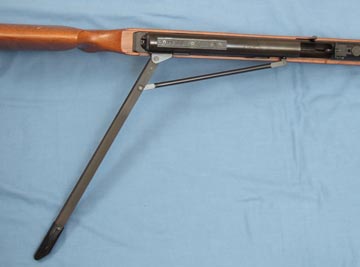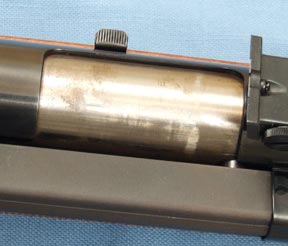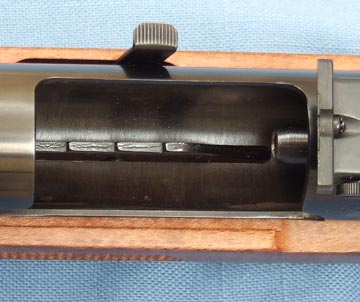by B. B. Pelletier
Before we begin, I noticed that there are some pellet packages in the Pyramyd AIR Gift Guide now. If you have someone who wants to give you a nice gift but doesn’t know much about airguns, these are great selections. Plus, they’re giving the 4th tin free in the promotion! Better hurry, though, because the best pellets will probably sell out as the season progresses.
We’re back on the RWS Diana 54 today, but if you are concerned that this rifle or the Whiscombe are going to hog this blog, don’t be. I will take plenty of breaks and do other airguns. I’ll need the time, because some of my future reports require trips to the range. Let’s look at several details I glossed over in the first report.
Cocking
I told you this is an easy rifle to cock, but now I’ll tell you why. The sidelever is arranged to provide superior leverage, and this is true for the Diana models 48 and 52, as well. It’s true the sidelever does add some weight to an already heavy airgun, but the cocking advantage makes it worthwhile in my opinion.

The action slides forward and locks up until the gun fires. When the piston springs forward, that pushes the action to the rear. The harsh impulse of the piston coming to a halt stops the action in its tracks, which removes every sense of recoil from the shooter.

The sidelever swings far to the rear, so the mechanical advantage is great. The strange thing about this picture is the fact that the rifle was not cocked! As I tell you in this report, the ratchet was holding the sliding chamber. The lever still goes back another 20 degrees.
Sliding compression chamber
This rifle has a compression chamber that slides to the rear, pushing the piston until it is caught and held by the sear. Then, the chamber is returned to the front to serve as the compression chamber for the shot. When it is in the rear position, the back of the barrel is exposed for loading. You can also see the steel ratchet that catches the sidelever should your hand ever let go during cocking. When the chamber is fully to the rear, that ratchet doubles as the anti-beartrap. Without this mechanism, your fingers would be sheared off if the chamber were to close while your fingers are in the way.

The silver cylinder is the sliding compression chamber.
On the left side of the stock there’s a button sticking up. It’s the release button for the ratchet, so you can slide the chamber forward once the rifle is loaded. If the button is ever difficult to push, back off, because the rifle is not cocked! The ratchet is holding the chamber, instead. Keep your hands off this button while you load the rifle! That actually happened to me while shooting the pictures for this report!

Here you can see the breech, which is very accessible for loading. The steel ratchet is seen at the bottom of the cylinder and the button standing proud of the receiver is the ratchet release. This one was holding the sliding chamber at the time, though I didn’t know it when I took the picture!
Next time, I’ll mount a scope and head to the range!
How does the sledge mechanism in the RWS 54 differ from that in the TX200SR? Many don’t like the Air Arms sledge (finicky, affects the feel of the trigger, etc.) but you seem quite positive about the RWS 54 sledge.
I hadn’t thought about it until your question. I owned an SR and I didn’t care for it at all. In contrast, I believe I am fgalling in love with the 54. I’ll hold off, though, until I see how it shoots.
B.B.
Now we’re talking…Fall in love with it.
The RWS54 gets too little respect it seems.
Maybe you can learn now to tweak the trigger to perfection and then teach your faithful.
Boy, don’t I wish! However, there has been a trigger change in the life of the 54. The T1 trigger has changed to the T5. It’s a simpler unit with a plastic trigger blade, and I don’t know how well it works.
We shall see.
B.B.
BB,
I like your post on the Whiscombe, very informative on things we do not have ready access to.
What do you think of a bullpup airgun? Any bullpup for that matter. But really, I am even thinking of a bullpup in a Whiscombe configuration if possible so I can do away with needing a recharge.
Thanks.
Dave
Dave,
Bullpups exist already. The Tech Force 89 is a springer bullpu,p. They have the same problems as bullpup firearms – poor balance and bad triggers.
B.B.
This is a little off subject, but can you tell me anything about the RWS model 25 air rifle made in west germany??????????
Jim P,
The Diana 25 (sold, but not made, by RWS) was Diana’s lowest-price adult-sized airgun when the 25/27/35 models were popular. Some 25’s had the ball-bearing trigger but most had a simpler conventional sear. They were low-powere rifles in both .177 and .22.
What else would you like to know?
B.B.
Thanks for the info. The “model 25” I have is marked with the RWS logo engraved on top of the receiver and was made in W Germany. It doesn’t say Diana on the rifle, or should it? Do you know the fps for the 177? I’m new to RWS so my questions may be on the dumb side. Also, would like any other info on the gun as I can’t find any info through any of the search engines.
Jim P
Jim,
Are you sure there isn’t an engraved picture of the goddess, Diana, throwing her bow away and holding an air rifle? RWS never made an airgun. They are the exclusive seller of Diana airguns, plus they buy guns from England, Sweden and China.
Your rifle shoud shoot about 550-600 f.p.s. It probably has a leather piston seal, so you should drop about 5 drops of household oil down the air transfer port and let the gun sit on its butt for an hour before shooting. The transfer port is behind the barrel when it breaks open to load.
The date your rifle was made is on the left rear. You must remove the stock to see the numbers and they are very small. It will be the month and year.
As far as info goes, just go to the main page (the current page) of this blog and type in your search terms in the search block. We’ve been up for nearly two years and there are over 400 postings here.
I’ve reported on the Diana 27 which is the next model up from the 25, and you might want to read that.
B.B.
I don’t see any Diana markings anywhere on the gun or stock. It has a 5 sided box with the letter “F” as a proof mark. It has the RWS engraving on the top along with the “model 25”. “Made in West Germany” is stamped on the side.
Again thanks for the info, as you can tell I’m fairly new to the world of airguning.
Also, it doesn’t have a safety. It has a hole in the trigger guard, but don’t see a place to adjust the trigger.
Jim P,
The F inside a pentagon is called a Freimark. It is required on every German airgun, to guarantee that it doesn’t exceed 7.5 Joules of energy (about 5.5 foot-pounds, or an 8-grain pellet going 556 f.p.s. at the muzzle. It’s an indication that your rifle was made for sale inside Germany, which might explain the lack of Diana markings.
Look inside the trigger area with the stock on. If you see two screws, you have an adjustable ball-bearing trigger. If not, you have the simpler one. They used the same triggerguard on all guns to save money.
B.B.
Jim P,
I forgot to mention that no airguns made during the time yours was (1950-1986) had safeties. They were considered superfluous, because it was the responsibility of the shooter to take care of safety. Only after the American legal system started going after manufacturers did safeties appear.
B.B.
hello… i´m from mexico… i hope you can help me.
i bought a used diana rws 54 and it come without instructions or manual.
i start using it and its great, but i notice that the screws on the bottom were some kind of loose, so i tight them hard, but then i notice that i began filling the recoil when i shoot. so then i loosen again a little bit the screws so the mechanism of the floating system function again.
so may question is: how much do i have to tight the bottom screws, or if it is ok not to tight them to much???? What do I have to do ???
thank you for reading this comment and sorry for my english, my grammar and spelling…jajaja.
happy new year!!!!!!!!!
Mexico,
That screw does exactly what you saw it do. It adjusts the tension on the recoil mechanism.
Adjust it just loose enough so the gun has no recoil.
Pyramyd AIR, the website that hosts this blog, has a large library of airgun manuals online. Manuals are linked from the bottom of the home page.
Your 54 manual is here:
/manual/RWS54
B.B.
BB,
thank you so much for the info.
Happy New Year.
Mexico.
Can you screw a bipod into this gun without damaging any internal parts?
Please…
I too want to mount a Bipod on the RWS 54
Yes, a bipod can be attached to the stock of a 54 without damage.
B.B.
Does anybody knows the techical specification about Air rifle "Diana 25" I will appriciate if someone writes all caracteristics about it… M
Diana 25,
Not quite sure what you mean about technical specification.
There's also a Diana model 25A, 25 Improved, 25D, and 25DS that appear similar, but they are completely unrelated with virtually no common parts.
The Diana 25 was also marketed as the Hy-Score 801 and also marketed as the Winchester 425.
The Diana model 25 Improved is a break barrel, spring piston, came in .177 or .22 caliber, blue finish, smoothbore or rifled barrel, metal rear sight, is 39.7 inches overall length, was manufactured 1933-1940 and 1950-1986.
kevin
how much the price ?
ical,
Price change all time. Click link in story to get today price.
B.B.